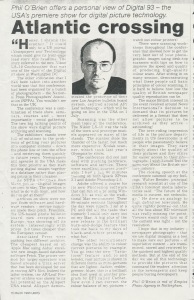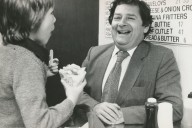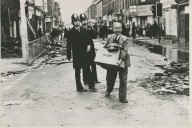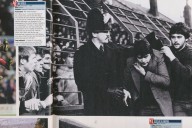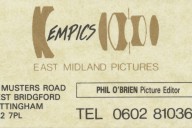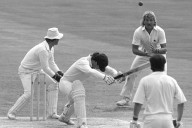
It’s hard to think that less than 20 years ago I had not heard of the internet. I suppose that in our lifetime it’s equivalent to how the Victorians came to rely on rail transport and electricity.
The speed of change from the early 90s was amazing – and I am glad that I was a close observer (and early adopter) of the technologies that grew out of this time.
Information was limited in those days – and I was seen as an “explorer” by attending a digital photography conference in the US each year hosted by the NPPA (National Press Photographers of America). The first I attended was “Digital 93” in Washington DC. I found a report that I was asked to write by the UK Press Gazette on my return. This was before the days of the internet (difficult to believe). The highlight of the conference was being allowed to try out Adobe Photoshop on a PC (up to that point it had only been available for Mac!).
The next year – “Digital 1994” – was in Miami. By then, I had seriously test-driven a digital camera at the Lillehammer Olympics. At Lillehammer, Kodak gave me the opportunity to us a prototype of a new digital camera. It was the first camera that I felt was truly professional. It had been a dream for a long while – and not just because I did not have to carry cases full of chemicals around to process film! The revolution in being able to take pictures digitally is difficult to understand now – but here is a comparison that will give you some insight.
| Digital | Film | |
| Set up before event | Laptop with access to phone line and electric | Laptop with scanner with access to phone line and electric. Chemicals to be mixed and warmed to correct temperature. Clean area available to wash and dry film |
| Early picture – Torvill & Dean come on to ice in show costumes to warm up | Card taken out of camera – replaced by new card. Transmitted straight away. | Film to be processed – around 20-30 minutes before ready to send |
| Start of Routine | Card taken out of camera – replaced by new card. Transmitted straight away. | Another film ready to be processed – but needs to wait if one already in tank |
| End of Routine – reaction to scores | Card taken out of camera – replaced by new card. Transmitted straight away. | Another film ready to be processed – but needs to wait if one already in tank |
| Finish of event | Put laptop away in bag – and go for beer | ….whilst film photographers finish sending and clean and dry film tanks and processing equipment in cases. |
Kodak reported they had processed over 700,000 films from photographers at the event – easy to see how Kodak’s business would be devastated by the change from film to digital. The talk at Digital 94 was about the future challenge of archiving all this digital photography. You can imagine how the change from film to digital would put a real pressure on storage of images. The convention had been to physically store each frame of film shot – and although this took space, it had little cost implication. At this time, 20GB of storage would cost over £25k – archiving digital photography was not a cheap option.
The biggest revolution was yet to come. At “Digital 95”, in San Francisco, the new buzz was about the World Wide Web! This report from the Cole Papers (an industry paper of the time that tracked digital innovation in the newspaper industry) shows how exciting it was for us all to see the WWW for the first time:
“New technology was available throughout the conference, as speakers had access to the Internet via a network that the Nppa installed and had running in under a day.
Four rooms and 23 computers were linked via Ethernet. A T1 connection to the Internet, supplied with the help of San Francisco-area ‘Net provider GeoNet, let participants show off their on-line projects.
Mostly it worked, but when it didn’t the live demonstrations showed both the potential and the numerous pitfalls of the digital-to-digital world. “Connection refused by host,” sluggish response times at popular World-Wide Web sites and a variety of other occasional errors served as reminders that however “way cool” this all may be, we still have a lot of work ahead of us before we park the delivery trucks.”
I remember sitting at one of those 23 terminals and experiencing the WWW for the first time on a Netscape 1.0 browser (might have even been pre-1.0!). It was clunky, ugly – but you could see the exciting opportunities ahead.
Always the early adopter, by 1996, we had embraced the idea of the internet – and in the summer worked with Sun Microsytems to deliver a photo database of images at the Atlanta Olympics to showcase their hardware. Sun generously supplied the kit – and we worked on the database design and content delivery. These were very early days of the internet. If I went to demonstrate the new system to a client it was often a struggle to get decent internet access. There was usually a very slow modem on one of the office’s slowest machines (companies were terrified that bringing the internet near to the main network would result in viruses).
I’m glad I played some part in this digital imaging revolution. Can’t believe how easily I can now take and send pictures with a couple of clicks of my iPhone!
My last “proper job” was in 1983-5. I was a photographer at the Leicester Mercury. It was one of the most enjoyable times of my life. Working within a community, making connections, then gradually gaining trust and respect is a rewarding process.
In 1981, I started my first job after school as a Trainee Press Photographer at Mercury Press Agency in Liverpool. I’d not bargained for my first week in employment to involve the coverage of some of the worst rioting on mainland Britain. I’ll always remember the phone ringing late at night after the family had […]
I lived in a council house on the ring road in Liverpool (Queens Drive) – and had very supportive parents (although I might not have thought so at the time). I went to a Catholic Boys’ Grammar School, St Francis Xavier’s – I and was very religious (up until the moment I was 18 – […]
In 1985, I was a 22-year-old press photographer in a well-paid and rewarding job at the Leicester Mercury. I had excellent colleagues – and a very comfortable life. However, it was not enough for me – and I wanted to work for National Newspapers and create my own business. So I set out to create […]
It’s amazing how easy it is to take and send high-quality photos these days. You can pick up an iPhone, take a snap and with a couple of clicks send the image around the world. It wasn’t always that simple – here’s a tale from 1985 (just over 25 years ago) when taking and transmitting […]
